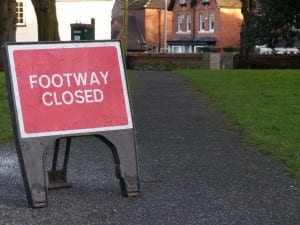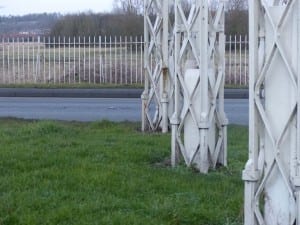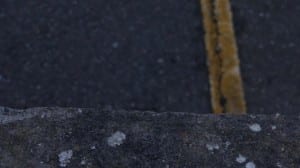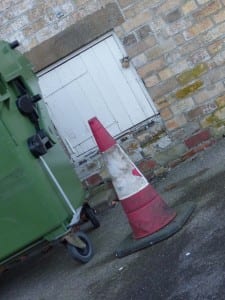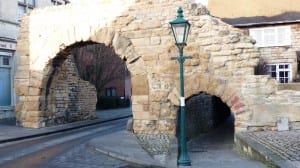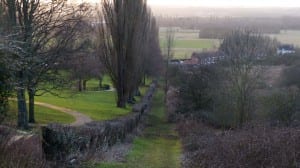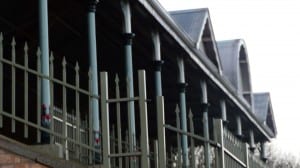Framing statement
“Site specific performance are conceived for, and conditioned by, the particulars of found spaces, (former) sites of work, play and worship. They make manifest, celebrate, confound or criticize location, history, function, architecture, micro-climate. They have an interpretation of the found and fabricated. They are inseparable from their sites, the only contexts within which they are ‘readable’”(Pearson,2010, 04).
The constant changing of time is a concern to use all, time is owned by no-one and we are all finding ways to outrun it. Our performance, named yOUR Journey, looked at the very aspect of time and the place and impact that Lincoln as a cultural and historical landscape has impacted upon its constant shifting topography around us. Using inspiration from sources such as, Blast Theory’s interactive performance ‘Can You See Me Now’ in 2004 & Talking Bird’s as well as verbatim monologues of those who lived in the developing area.
Our performance took place in a decrepit and forgotten playground as Talking Bird’s states on performance spaces, “places that you might stumble across by accident. Places which have interesting features, histories and former uses, perhaps layered with recollections and associations which are on the brink of slipping from living memory” (Talking Bird’s,2015).
Site-specific performance is vastly different to that of conventional theater, tearing down the facade and safe environment that traditional theater evokes, and instead placing you within the transformable and often surreal experience of the fractured real world, looking at Joanne Tompkins methodology I realised that site performance is, “to recontextuailizelise performance, just as performance can reformulate how we perceive and experience space and place”(Tompkins et al,2012, 01).
Overall our silent performance took over twenty minutes, the reason for this was to show a constructed representation of time that led the participators on an interactive journey, that incorporated the use of audio/video media of a pre-recorded walk of the same route previously taken by us as performers. This was overlaid with audio and interesting/informative information about the developing and changing area. It centered on the past, the present and the ideological future of tomorrow and our place within an observed, uniformed and maturing society. Taking place on recreational space near Archer’s & Kesteven street, on the 7th May 2015 during a seemingly quiet afternoon, unexpected and unannounced. We openly transformed the site into one of reflection and interactive imagery, that could be openly explored and changed, with the use of repetitive actions to illustrate our point, and the contentiousness occurrence of change over a small period of time. Being a spontaneous event passer-bys were encouraged to engage however this was to little avail, and the only interactions with our performance was carried out by our lecture’s who were led to our ‘intervention’ and asked to walk around the space, observing, interacting where they felt at ease using chalk as there main source of communication, to interact with our performance and there thought’s/feelings of the space, along with small instructions to help continue the experience. Our location was chosen after a exploitative ‘drift’, and as a collected group we ventured aimlessly through Lincoln’s busy and congested streets without a predetermined end. We decided that in order to interact with the city we should find ourselves in a location that most passer-bys would avoid. Our drift took us down winding alleyways and crumbling buildings that had long seen better days, until we decided to explore a once joy filled location that now inspired dread and disillusion.
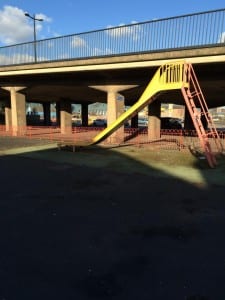
Figure one (Your Journey Lincoln 2015).
Analysis Of Process
Beginning with a below-basic understanding of audio production is a daunting thought when thinking of the journey that lay ahead of us when creating a site-specific audio piece that is explored by an outside viewer. Through exploring the range and standards that original professional site-specific/generic pieces had captured on a large scale, led us to the creative ideas that would later form our ‘intervention’, within the consent shifting landscape. Our ‘drift’ as a group was crucial to this process as without a ‘drift’ there would be no experience for us as performers to engage with, and no way to share our experience with an unsuspecting viewer. Our intention was to show a new journey hidden within Lincoln’s vast culture and growing society. While drifting we found several places such as public walkways, bridges and even abandoned alleyways, however these seemed impracticable within the space they provided. Continuing on we arrived at a forgotten historic building lost in Lincoln’s past; Lincoln Equitable Cooperative Industrial Society, the building was architecturally impressive but this was merely a facade as through further research we saw the building had fallen into dark times and needed dire repair, and so was structurally unsafe to use as a performance venue for our interactive audio piece. Undeterred we continued on our ‘drift’ and stumbled across a frankly depressing, disgusting and un-nurtured park, little known to us as a group that this would be our chosen location. Entering this location for the first time as a group we were struck by not only the space it entrapped, but also as a performance site the potential it had hidden within. It was unused, unloved and time had simply let it become nothing but a secluded, uninviting smudge on a blurred, changing landscape. As Miwon Kwon explores innovative locations, “the uncontaminated and pure idealist space of dominant mod-ernisims was radically displaced by the materiality of the natural landscape or the impure and ordinary space of the everyday”(Kwon,2004 ,11).
The park was an ideal interactive space as it was almost absent from the surroundings around itself, the only physical memory that showed its previous glory was that of a large and striking slide that had been left to rust. Upon investigating the future of this location we found that no credible source of information was available and this only added to the mysterious and saddening environment we had chosen. Through this I feel it led us to the identification of time as performance and as interactive concept, and this would influence all our future work as it developed.
With many different and exciting ideas on which to explore inspired by videos such as (Niemandsland, 2013), which used names and messages to create a continuous, spontaneous ‘intervention’ on a large scale. However with budget restrictions and location in mind we began the intimidating task of pin-pointing the kind of audio experience we wanted to show about Lincoln’s fascinating heritage, through our task of creating a plus twenty minute audio journey from one set location to another. Choosing Lincoln Performing Art’s Center as our starting point due to its busy and recognizable location, we created a journey in which anyone could take part, regardless of background knowledge they knew or needed. Research for our piece came from hours of searching through various online archives, in order to find historical non-fictional accounts of those who had experienced Lincoln’s bygone years. Upon researching we found the original historical name now known as Lincoln to be, ‘Lindum Colina’ and this inspired us on our historical journey. Further research uncovered audio/video media of a man from 1935 narrating his surroundings in the early years during the development of Lincoln, far from what it is today. Simply listening to the video we heard statements such as, “ Lincoln is one of the most interesting city’s in England, with a history going back to the ancient Britons”(British Pathe, 2014). This finding was crucial when developing the style of our piece and eventually would feature as one of the main sources of information within our finished audio track, along with our own independent research including videos of those who had grown up in Lincoln (Cambelltown Life Story Circles, 2013).
Focusing on the conceptual identification of time we began to devise a working script that could be moulded and shaped to fit any future inspiration we have in our developing understanding. I could lie and say creating a script was easy, however that would be a lie, and I have to admit it has been one of the more challenging, yet constructive barriers I have overcome with time and tolerance. This alongside itself brought the challenges of producing audio into a format that could be presented in a range of suitable and approachable ways. To combat this each member of our group was allocated a role that they were best suited to, so that one person was not solely responsible. This seemed to an effective use of time between absences or other university commitments.
Through deeper discussions with our tutor we were asked whether or not a video of our journey alongside our audio would be a beneficial aid, in order to show the movement that time has taken on the city around us when we first started our project. After a brief discussion we decided to incorporate this as a visual travelling companion that could be viewed and listened to during transit to our ‘intervention’ site, and to make sure it was viewable on all media devices, & create a separate blog with information about our performance that could be openly accessed in order to follow our process and our interactive video journey (yourjourneylincoln, 2015). Our video could be argued to show the use of phenomenology, defined as by Robert Sokolowski as, “every act of consciousness we preform, every experience that we have, is intentional: it is essentially “consciousness of” or an “expe-rience of” something or other”(Sokolowski,2000, 01). Our intention was to make the observer aware of every footstep that they were taking was being echoed from the past of a previous journey already taken. As Pearson observes,“you begin to make perceptual judgements about distance and dicer-tion, near or far, this way or that way”(Pearson,2010, 29). Filming our journey through the use of a GoPro allowed us to capture the real world and a first-person perspective of changing of time, seen not only through a viewer’s eyes but that of a captured image, poetically capturing the moment to be viewed whenever desired, this was a personal and a emotive experience, unlike that of the fleetingness of time which is lost forever. The idea of being lost in time also linked to the concept of silence and how this would integrate effectively into our piece, companies like Forced Entertainment’s Tim Etchells explores the use of silence in performance and the communication it expresses saying it is like, “the kind of silence that has everything in it” (Etchells, 1999, 108). Also with the idea of a silent performance it draws attention to distractions in the ‘intervention’ as Etchells states, “by noise, by interruptions, by the actions of other performers”(Etchells, 1999, 110).
After many re-shoots for various reasons such as sound quality or visual deficiency’s, we at last finalized our visual element to our piece. Our audio in comparison was far easier as it required several attempts to finish and through the use of past sound recordings experimentation and also the program audacity, which in earlier sessions we had briefly explored and was now fairly at ease with, and through now knowing how to manipulate audio in order to improve its quality, and add ambient noise to fill in any dead space within our audio. We also wanted our audio to be in sync with that of our journey, and so painstakingly the process of chopping, cutting and extending audio tracks so that they would fit within a real time-scale in the outside world. Through the use of music tracks we were able to breakup the information that was being given and create a relaxed pace from which to listen, while walking the predetermined route we had already arranged. Having the advantage of having the use of a good quality recording microphone, we were able to create a clear, concise audio piece. Ensuring that everyone had also contributed to the final recording was simply done by having each person read a small section of our script, varying our tone and voice so as not to become repetitive. During the final cut and also this was easier to detect were words/phrases may have become distorted during the original recordings.
However the question remained, what would our physical performance be? There were many ideas to begin with but we wanted to ensure that participators were able to interact in our ‘intervention’, and so through the manipulation of practices associated with playgrounds/recreational spaces we spoke about using paint to define childish imagery, and the idea of time maturing while spectators were inside our ‘intervention’. Of course with the idea of painting we began to explore the practicality of using this medium in an open environment, we also had to consider the lasting impact on our site and the lasting damage that could be created, from using the park as large blackboard on which we could articulate our emotions. Eventually through experimentation we decided on the medium of chalk as a suitable substitute for paint. Inspired through our discovery of the term simulacrum the identification of an image or representation of someone as discussed by Jean Baudrillard and Mark Poster as ,“the simulacrum is never that which conceals the truth–it is the truth which conceals that there is none (Baudrillard and Poster, 1988). This linked to the idea of a forgotten space and had proved to be useful when looking into deeper research of what our performance could elevate to.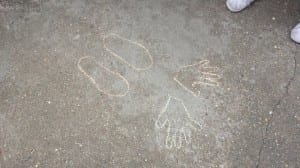
Figure Two (Your Journey Lincoln 2015).
Using typography for example the study of text to explore Lincoln’s past and writing future messages through this medium as it still invokes childish connotations, and is more easily accessible and more significantly less harmful to the surrounding landscape, and less likely to cause a disturbance to nearby residents or the local council, who we were unable to gage a productive response from, despite unproductive countless attempts.
Our final rehearsal of our looming performance can only be described as a exploration of ideas and scenarios that could unfold throughout our changing performance within our ‘intervention’ site. We were also constrained by time, as the night before while carrying out final checks we had discovered that our performance video had rendered in it’s entirety with no under-laying audio what so ever. This left us with a harsh ultimatum of the choice to discard the video media, or spend the very early hours in the university’s mac room, praying that it would render it time. During final discussions we made the choice that the video media was crucial to our performance and we would have to wait until a new uncorrupted copy had rendered. This took several hours as technology is known to be unreliable and often unpredictable and would without warning turn off during the rendering process, leaving all of our work lost. It was only through spending the night in the mac room that we were able to leave at eight in the morning knowing we had a working video/audio piece. Arriving at our ‘intervention’ site we discussed the final imagery we would display and the type of messages that would help to show our ‘intervention’ in the broken facade of time.
We discussed and developed the structure of our piece by including the concept of repetitive action, similar to that of which had been explored in class of the impact and mundanity of a continues repetitive cycle. With the example of the same breakfast given to a patient everyday for several years.
We also discussed how we could incorporate the slide into our piece through the repetitive action of drawing on the ground in chalk and then passing down the slide, in theory this gave a literal sense to the increasing and negative effects that were changing the landscape around us.
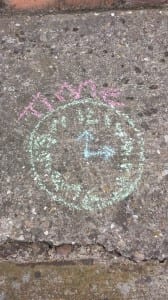
Figure Three. (Your Journey Lincoln,2015).
Performance Evaluation
Overall I would say the end product of our process was one of reflection and relief. Even though we only had two main participators, consisting of our lectures who understood the performance we were trying to convey, we did however have the unsuspecting public who seemed amused and often alarmed at the thought of defacing a closed off space. I would argue this was interesting and also captured our aim, as we wanted the location to stand out rather then be forgotten as it always had been previously. There were worries that our piece would seem non interactive, maybe even intimidating, however we quickly were assured when our tutors joined in and followed the instructions they were been given within the ‘intervention’. The only issue we mainly faced was running out of our means of communication, the medium chalk. It seems poetic that over time the chalk would erode within our space without warning, much like that of time. Our performance was undertaken in complete silence and we all had roles to play. One such role was after each participant had drawn an image on the ground, it would slowly be wiped away, and replaced with another image that had evolved into a new form or subject, therefore showing the entrapment of time within a closed space. One crucial criticism we received from one of our observers was the overall sound quality of our piece, and the strain it had placed upon a listener in the loud and active streets of Lincoln’s high-street. This could be argued to have been avoided through the use of better software or a soundproofed room, or through the use of noise cancelling headphones. However this is something that could easily be addressed if the performance was to be developed for future use.
To summarize I felt we delivered a compelling and visually stimulating interactive experience, that was unique to the city of Lincoln and its burden of the shifting sands of time. It felt natural and unapologetic and broke the facade of the conventional sit-down theatrical experience, in order for realism to take its place.
The subject of site-specific as a whole taught me that acting has many forms and does not have to be surrounded by the comfortable surroundings and safety-net of a theater, and instead you can invest yourself and also entice others into a performance space, that is unused and even unconventional to create something entirely owned by itself. As Pearson explores performance outlining,
“our appreciation is not confined to the features of landscape and terrain. We are always aware of the men and women who have lived in these parts and the history of which they have shaped”(Jones, 1985, cited in Pearson 2010, 101).
Word count- 3,053
Bibliography
Anna Starbuck.(2015) yOUR Journey Lincoln. [Online] Lincoln: Available from https://www.youtube.com/watch?v=rdtQSaearoY [Acsessed 09 May 2015].
Birch, A. and Tompkins, J. (2012) Performing Site-Specific Theatre: Politic, Place, Practise. London: Palgrave Macmillan.
Baudrillard, J and Poster, M. (1998) Simulacra and Simulations. [Online] Stanford: Available from http://web.stanford.edu/class/history34q/readings/Baudrillard/Baudrillard_Simulacra.html [Acsessed Online 09 May 2015].
British Pathe. (2014) City Of Lincoln (1935) [Online] Lincoln: British Pathe. Available from https://www.youtube.com/watch?v=fNKuYdFAuAY [Accessed 08 May 2015].
Campbelltown Life Story Circles. (2013) Margaret- Lincoln UK Growing up. [Online] Lincoln: Available from https://www.youtube.com/watch?v=b43j1HkNMvY [Acsessed 08 May 2013}.
Dries, Verhoeven. (2013) niemandsland utrecht 2013/ trailer. [Online] Dries Verhoeven. Available from //vimeo.com/73218446 [Accessed 08 May 2015].
Etchells, T. (1999) Certain Fragments: Contemporary Performance and Forced Entertainment . Oxon: Routeledge.
Kwon, M. (2004) One place After Another: Site-Specific Art and Locational Identity. USA: Massachusetts Institute of Technology Press.
Sokolowski, R. (2000) Introduction to Phenomenology. Cambridge: Cambridge Univeristy Press.
Pearson, M.(2010) Site-Specific Performance. England: Palgrave Macmillan.
Talking Birds. (2015) About Talking Birds. [Online] London: Talking Birds. Available from
http://www.talkingbirds.co.uk/pages/about.asp [Accessed 08 May 2015].
yourjourneylincoln. (2015) yOUR Interactive journey. [Online] Lincoln: Available from https://yourjourneylincoln.wordpress.com/about/ [Accessed 08 May 2015].
Figure One (Your Journey Lincoln 2015).
Figure Two (Your Journey Lincoln 2015).
Figure Three (Your Journey Lincoln 2015).
